Harvest Love |
||||||||||||||||||||||||||||||||||||||||||||||||||||
 |
 |
|||||||||||||||||||||||||||||||||||||||||||||||||||
Crochet DROPS jumper with crochet squares and lace pattern in ”Nepal”. Size: S - XXXL.
DROPS 171-35 |
||||||||||||||||||||||||||||||||||||||||||||||||||||
|
PATTERN: See diagrams A.1 to A.9. COLOURS-1 (front/back piece): Rounds 1-3: grey Round 4: camel Rounds 5-6: beige Round 7: light grey Round 8: beige Round 9: camel Round 10: grey Then work with grey. COLOURS-2 (sleeves): Work with grey to and with 5th-3rd-3rd round. Then 1 round beige, 1 round camel, 3 rounds grey, 1 round light grey, 1 round beige and 1 round camel. Continue with grey. CROCHET INFO-1: Replace first dtr at beg of every dtr round/row with 4 ch. Finish round with 1 sl st in 4th ch. Replace first triple tr at beg of every triple tr round/row with 5 ch. Finish round with 1 sl st in 5th ch, work sl sts until beg of next dtr. CROCHET INFO-2 (applies to shoulder): At beg of every row with dtr work 4 ch, finish row with 1 dtr in last triple tr on row. Beg every row with triple tr with 5 ch, finish row with 1 triple tr in last dtr on row. DECREASE TIP: Work 1 triple tr but wait with last pull through (= 2 sts on hook), then work next triple tr but on last pull through, pull yarn through all sts on hook = 1 tr dec. DTR TOG: 3 dtr tog into 1 dtr as follows: Work 1 dtr but wait with last YO and pull through, work 1 more dtr the same way, work 1 dtr more but now pull last YO through all sts on hook. TRIPLE TR TOG: Work 3 triple tr into 1 triple tr as follows: Work 1 triple tr but wait with last YO and pull through, work 1 more triple tr the same way, work 1 triple tr more but now pull last YO through all sts on hook. 5-DTR: Make 5 YOs on hook, get the yarn under ch-space, * 1 YO on hook, pull yarn through the next 2 sts on hook *, repeat from *-* 5 more times = 1 st on hook. 4-DTR: Make 4 YOs on hook, get the yarn under ch-space, * 1 YO on hook, pull yarn through the next 2 sts on hook *, repeat from *-* 4 more times = 1 st on hook. 4-DTR TOG: Work 3 4-dtr into 1 4-dtr as follows: ** Make 4 YOs on hook, get the yarn under ch-space, * 1 YO on hook, pull yarn through the next 2 sts on hook *, repeat from *-* 3 more times, **, repeat from **-** 2 more times (= 4 sts on hook), 1 YO on hook, pull through all sts = 1 st on hook. ---------------------------------------------------------- FRONT PIECE: First work a square the same way in all sizes. Then work in the round and back and forth on square (different in the different sizes). SQUARE: Work 6 ch on hook size 5.5 mm with grey and form a ring with 1 sl st in first ch. Continue in the round according to diagram A.1 - READ CROCHET INFO-1 and COLOURS-1. Then work A.2, A.3 3 times in total in width, finish with A.4. REMEMBER THE CROCHET TENSION! When A.2-A.4 have been worked, there are 55 triple tr along each side, and 4 corner spaces. Square measures approx. 48 x 48 cm. SIZE S/M: Then work in the round according to A.5 over triple tr along each side, around each corner space work A.6. When A.5/A.6 have been worked, 10 triple tr have been inc along each side (= 65 triple tr). Cut the yarn. Now work left shoulder along side-1 (see chart) beg from WS as follows: The middle 9 triple tr are no longer worked (= neck). Beg to work in next triple tr as follows: Work A.8 over the first 13 triple tr, A.5 the entire row as before, around corner space work A.5 (dtr on 1st row in A.5 work around ch-space). When A.5 has been worked vertically, work 1 row as follows: Work 1 dtr in each triple tr Cut the yarn. Now work right shoulder along the end of side 1, beg from corner from WS: - READ CROCHET INFO-2. Work A.5 over ch-space, A.5 until 13 triple tr remain before neck (= 9 triple tr), work A.7 over the next 13 triple tr. When A.5 has been worked vertically, work 1 row with 1 dtr in every triple tr. Fasten off. SIZE L/XL - XXL/XXXL: Then work in the round according to A.5 over triple tr along each side, around each corner space work A.6. When A.5/A.6 have been worked, 10 triple tr have been inc along each side (= 65 triple tr). Cut the yarn. Now work back and forth along the end of side 1 (see chart), then work along side 2, 3, 4 and beg of side1 beg from WS as follows: The middle 9 triple tr are no longer worked (= neck). Beg to work in next triple tr as follows: Work A.8 over the first 13 triple tr, A.5 the rest of row as before, then work A.6 around the corners and A.5 along the sides as before - work like this back and forth to and with last corner (i.e. along side 2, 3 and 4), then work along the beg of side 1 as follows: A.5 until 13 triple tr remain before neck (= 9 triple tr), work A.7 over the next 13 triple tr. When A.7/A.8 have been worked vertically, there are 75 triple tr along side 2, 3 and 4, and 25 triple tr on each side of neck. Now work differently in the different sizes. SIZE L/XL (shoulder): Now work left shoulder, from WS as follows: - READ CROCHET INFO-2. Work 1 dtr in every triple tr the rest of row on side 1, around first ch-space in corner space work 5 dtr. Fasten off. Work right shoulder the same way, but beg around corner space at beg of side 1 from WS. Size XXL/XXXL: Next row beg from WS. Work A.5 over A.8, continue A.5 along side 1, 2, 3, 4 and 1 and A.6 around corners as before, finish with A.5 over A.7. When A.5/A.6 have been worked 1 time vertically, work shoulder the same way as in size L/XL, fasten off. BACK PIECE: Work the same way as front piece but without dec for neck, i.e. work A.5 over all sts along side 1 (instead of A.7/neck/A.8). ASSEMBLY: Sew shoulder seams in front loop of outermost sts. Sew side seam as follows: Beg approx. 8 cm from bottom edge (= vent), and sew up to approx. 19-21-23 cm remain until shoulder (= armhole). SLEEVE: Work in the round from armhole and outwards. Beg from mid under armhole in the side. Work 50-55-60 dtr on hook size 5.5 mm with grey evenly around armhole (work in/around triple tr/ch-space) - READ COLOURS-2 and remember CROCHET INFO-1! READ ALL OF SLEEVE BEFORE CONTINUING! Work as follows: Work A.5 (= 10-11-12 repetitions in width). Continue in the round until 5-4-4 repetitions have been worked vertically, then work A.9 over A.5 1 time in total vertically, and A.5 over A.9 2 times in total vertically, then size L/XL work 1 round with 1 dtr in every triple tr. AT THE SAME TIME dec 5 triple tr evenly on round with triple tr (= 1 repetition less on every round with dec) as follows: SIZE S/M: 5th, 7th and 13th round. SIZE L/XL-XXL/XXXL: 5th, 7th, 11th and 13th round. When all dec are done, there are 35-35-40 triple tr on round (= 7-7-8 repetitions in width). Fasten off, sleeve measures approx. 43-40-38 cm (shorter measurements in the larger sizes because of wider shoulders). Work another sleeve the same way. NECK EDGE: Work an edge around the neck opening with grey. Start on shoulder and work as follows: * 1 dc around outermost st, 2 ch, skip approx. 1½ cm *, repeat from *-* around the entire opening, finish with 1 sl st in first dc. Fasten off. |
||||||||||||||||||||||||||||||||||||||||||||||||||||
Diagram explanations |
||||||||||||||||||||||||||||||||||||||||||||||||||||
|
||||||||||||||||||||||||||||||||||||||||||||||||||||

|
||||||||||||||||||||||||||||||||||||||||||||||||||||

|
||||||||||||||||||||||||||||||||||||||||||||||||||||
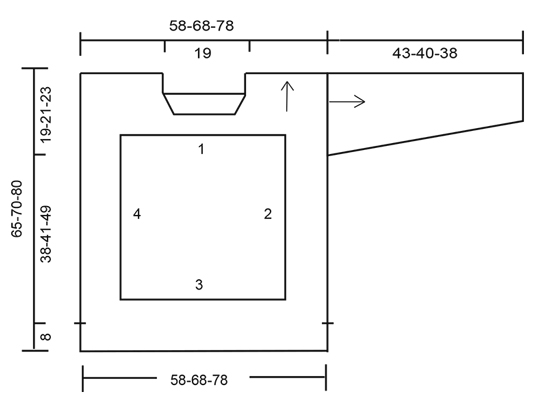
|
||||||||||||||||||||||||||||||||||||||||||||||||||||
|
Have you made this or any other of our designs? Tag your pictures in social media with #dropsdesign so we can see them! Do you need help with this pattern?You'll find tutorial videos, a Comments/Questions area and more by visiting the pattern on garnstudio.com. © 1982-2024 DROPS Design A/S. We reserve all rights. This document, including all its sub-sections, has copyrights. Read more about what you can do with our patterns at the bottom of each pattern on our site. |
||||||||||||||||||||||||||||||||||||||||||||||||||||








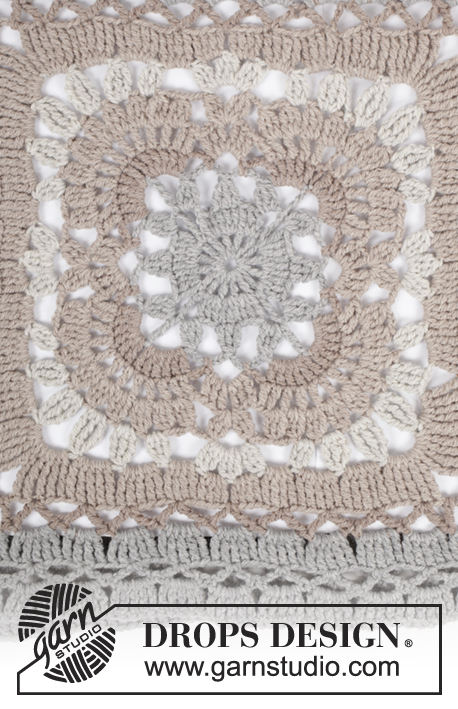



























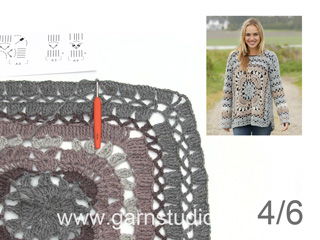



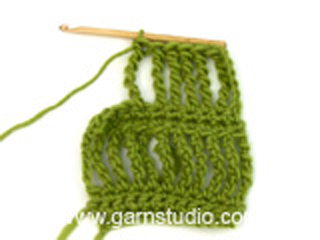





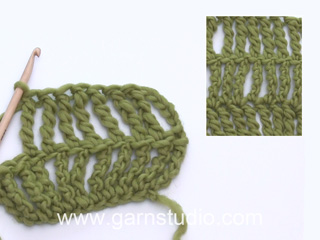













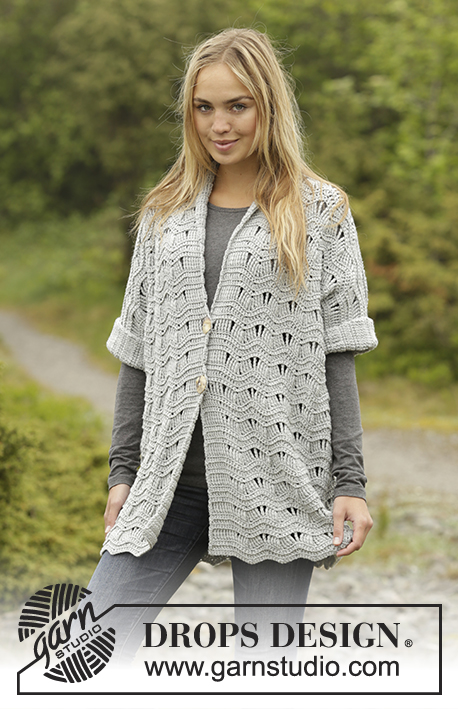






Comments / Questions (41)
Des difficultes apres le carre pour realiser coins notamment...9 triples brides du milieu du cote 1 ne sont plus travaillees.... Coins comment evoluent ils apres le carre? J ai l impression de tout melanger un dessin plus complet aurait ete mieux pour moi.... quelqu un. Peut m aider? Merci
16.10.2017 - 16:48DROPS Design answered:
Bonjour Luis, les 9 triple-brides au milieu du côté 1 sont pour l'encolure. On va crocheter maintenant chaque épaule (en taille S/M) ou continuer le carré à partir de l'épaule (autres tailles) après ces 9 triple brides et continuer ce côté/le rang jusqu'à l'autre côté du côté 1 en veillant à laisser ces 9 mailles non travaillées pour l'encolure. Bon crochet!
17.10.2017 - 09:25Penny wrote:
I'm struggling with the tension for this jumper. I've resorted to attempting the A5 gauge (I'm not very good at gauges) with a 4mm hook but it's still slightly more than 5cm. Can a hook 1.5mm smaller than required be right!? Thanks for any advice.
24.09.2017 - 18:21DROPS Design answered:
Dear Penny, the way we crochet or knit can vary by each person widely. I personally knit/crochet very loosely, and often use needles in sizes 2 mm smaller than suggested. So, you should always nake a gauge swatch, and keep trying to find a needle with which you can achieve the given gauge, even if it is one or even 2 mm off from the suggested size. I hope this helps. Happy Crafing!
25.09.2017 - 00:09Wendy Nice wrote:
Thank you for this lovely pattern! I am working the back piece. I have finished the square, and the round of A.5/A.6. After I finish A.5 over all sts along side 1, should I then work one row with tr in every dtr as instructed for the front piece? I can't tell from the video if the tr row is on the back piece also. Thanks for your help!
14.07.2017 - 00:20DROPS Design answered:
Hi wendy, Glad you like the pattern! Yes, you work the back piece as instructed for the front piece, but without the decreases for the neck. Happy crocheting!
14.07.2017 - 08:49Ik ben gekomen tot 10 dubbelstokjes gemeerderd naar 65 driedubbelstokjes (A5 en A6 zijn nu klaar). Ik wil maat L maken. In het patroon staat: haak nu heen en weer langs het einde van kant 1. Moeten er nu extra toeren gehaakt worden voor ik aan de schouder begin of begin ik net als in maat S en M aan de schouder? En als ik extra toeren moet haken langs kant 1 voor ik aan de schouder moet beginnen, hoeveel toeren en welke steken?
12.06.2017 - 18:53DROPS Design answered:
Hoi Veronique, In het patroon staat voor jouw maat precies beschreven hoe je dit doet. Haak nu heen en weer ...als volgt: Je kunt gewoon de beschrijving volgen die achter 'als volgt' staat. Veel haakplezier!
13.06.2017 - 14:56Hi there. While I'm thoroughly enjoying this project, I seem to have hit a problem with a particular instruction for the sleeve i.e. 'dec 5 triple tr evenly on round with triple tr (= 1 repetition less on every round with dec). Is there a video that shows how to do this as I'm not sure how to proceed. Many thanks.
19.05.2017 - 12:31DROPS Design answered:
Dear Sandy, when dec 5 triple tr evenly, work 2 triple tr tog evenly distributed on row - see here how to dec evenly. To work 2 triple tr tog: Work 1 triple tr but wait with last YO and pull through, work 1 more triple tr the same way, but now pull last YO through all sts on hook. Happy crocheting!
19.05.2017 - 13:50I love this pattern and the video instructions are very helpful. I have noticed the colors in the video differ from the picture in the pattern. What colors are the ones in the picture? I would much prefer shades of blue. Also, there is a color you are out of stock, the 0300 beige, when do you expect that in stock? Best, Grace
04.03.2017 - 13:40DROPS Design answered:
Dear Mrs Day, you will find required colours and materials under tab "Materials". You are welcome to contact directly your DROPS store for any further assistance choosing colour or about their own stock. Happy crocheting!
06.03.2017 - 09:03Ik ben gekomen tot 10 dubbelstokjes gemeerderd naar 65 3 dubbelstokjes per kant. Ik wil maat L/XL verder maken maar loop volledig vast. Met de video ernaast lukt het me ook niet omdat die de kleinste maat laat zien. Verder ben ik heel blij met deze video's. Ik leer er veel van. Maar nu kom ik er niet meer uit.
09.11.2016 - 22:38DROPS Design answered:
Hoi Sandra. Het principe is hetzelfde als in de kleine maat, je hebt alleen meer stk op de grotere maat.
10.11.2016 - 14:54Sara Constanza Lara Falla wrote:
Hola buenta tarde. Soy de Bogotá, Colombia y estoy interesada en comprar el material de este proyecto, me podrian indicar si aca se consigue este material?
23.09.2016 - 00:35DROPS Design answered:
Hola Sara. De momento no tenemos tiendas en Colombia. Puedes comprar en una tienda online que tiene envíos internacionales: https://www.garnstudio.com/findastore.php?s=w&cid=23
23.09.2016 - 19:08Hej! Jag förstår inte riktigt hur jag ska minska antalet maskor/stolpar på ärmarna, jag tycker bara att de blir större. Har fattat det som att man ska minska en 3-dst jämt fördelat för att i slutändan ha gjort denna minskning 5 gånger. Men jag får ändå inte till det! Det är fortfarande 10 rapporter på bredden! Virkar man två 3-dst ihop under samma maska? Är det något annat sätt man ska göra det på eller är det jag som läser instruktionerna fel? Med vänlig hälsning Amanda
22.09.2016 - 17:29DROPS Design answered:
Du minskar genom att virka ihop stolpar så här: Virka 1 3-dst, men vänta med sista genomdragningen (= 2 m på nålen), virka sedan nästa 3-dst, men när sista genomdragningen görs dras tråden genom alla m på nålen - det har nu minskats 1 st. Du virkar alltså i olika maskor.
20.04.2017 - 16:47Sue Cone wrote:
I have made up this jumper in big delight and my children are fighting over it. It is lovely. I will a photo soon. It is a very quick pattern.
21.09.2016 - 02:44